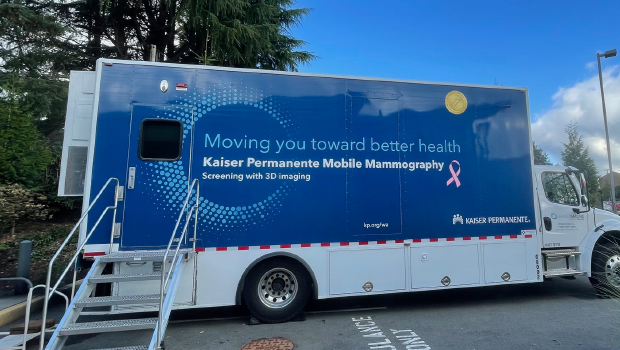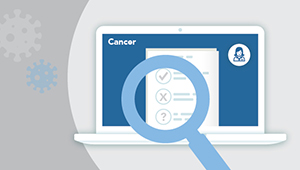Prioritizing breast cancer screening during COVID-19

Mobile mammography vans are one way Kaiser Permanente Washington has expanded access to mammograms during the COVID-19 pandemic. (Photo: Melissa Parson)
As breast cancer screening rates rebound, Erin Bowles, MPH, reflects on maintaining “pink ribbon” awareness year-round
By Erin Bowles, MPH, senior research associate, Kaiser Permanente Washington Health Research Institute
October signals many things — changing leaves as fall gets into full swing, pumpkin-spice-everything on the shelves, the excitement of kids as they think up costumes for Halloween. It’s also Breast Cancer Awareness Month — that time of year when pink ribbons abound in an effort to raise support and awareness for breast cancer screening and survivorship. I understand the meaning behind it. But as a breast cancer researcher, I think supporting breast cancer screening and people with breast cancer requires more than pink ribbons once a year. And the COVID-19 pandemic has only amplified the importance of supporting breast cancer awareness all year long.
COVID-curtailed screening
One of the challenges of COVID-19 in the acute phase of the global shutdown was providing preventive care that requires individuals to come into clinic for services — like mammography.
At the start of the COVID pandemic, breast cancer screening rates dropped dramatically. Recent work from the Breast Cancer Surveillance Consortium (BCSC), a national network of breast imaging facilities across the U.S. including Kaiser Permanente Washington (KPWA), showed screening rates in April 2020 dropped to 1% of normal compared to rates in April 2019. Screening rates at the BCSC facilities improved slowly as clinics opened up for nonurgent care but didn’t return to pre-pandemic rates right away. Compared with 2019 rates across all BCSC sites, rates were at 37% of capacity in May 2020, 84% in June, and 90% in July. Much of the decrease was due to facility closures and limited capacity of screening and diagnostic mammography in 2020. But some was due to people’s concerns about possibly being exposed to COVID-19 when visiting facilities for an in-person screening exam.
Pivoting to provide access
The drop in breast cancer screening was no surprise to radiologists at KPWA. After mammography clinics reopened for screening in May 2020, people were still hesitant to return. BCSC researchers learned quickly what concerned patients about returning for screening by talking with women across the country, including some at KPWA. Women were juggling dual concerns about the risk of COVID-19 versus the risk of undetected cancer, and they wanted to feel safe when undergoing screening.
KPWA mammography clinics quickly pivoted to adopt numerous safety measures, including extra cleaning and socially distanced appointments to encourage people to come back. In addition, KPWA increased access and capacity by adding Saturday appointments to several clinics and starting a mobile mammography van that travels to primary care clinics.
Milestone reached, more work ahead
Ever since the pandemic started, Diana Buist, Carolyn Eng, Deb Seger, and I have been working with Loree McGill, Clare Springer, and the KPWA mammography team to monitor how these improvements have met the needs of KPWA members during the pandemic. All the work our clinical teams have been doing — providing socially distanced mammograms and increased access — has definitely made a difference. We are seeing screening mammography numbers back to pre-pandemic levels!
But the 2020 decline in screening is still worrisome. People who missed screening during the pandemic may still not have received their mammogram. This puts more people at increased risk for a later-stage breast cancer diagnosis and potentially an increased risk of dying of cancer. And with the COVID-19 delta variant, some people may still be wary of returning to their mammography clinic in-person. That’s completely understandable. But it’s also why we can’t limit breast cancer awareness to October. We need to encourage breast cancer awareness during the other 11 months, too. And it’s why I’m proud to work with our mammography leaders at KPWA — they’ve been working non-stop to create more opportunities for people to be screened for breast cancer and increase their chances for early detection all year long.
Cancer screening

Catching breast cancers when mammograms are limited
New study calculates risk-based approach to detect the most cancers with the fewest exams.
Healthy Findings Blog

Cancer screening in the time of COVID-19
Dr. Diana Buist reflects on the challenges of providing screening during a pandemic — and finds reason for optimism.


